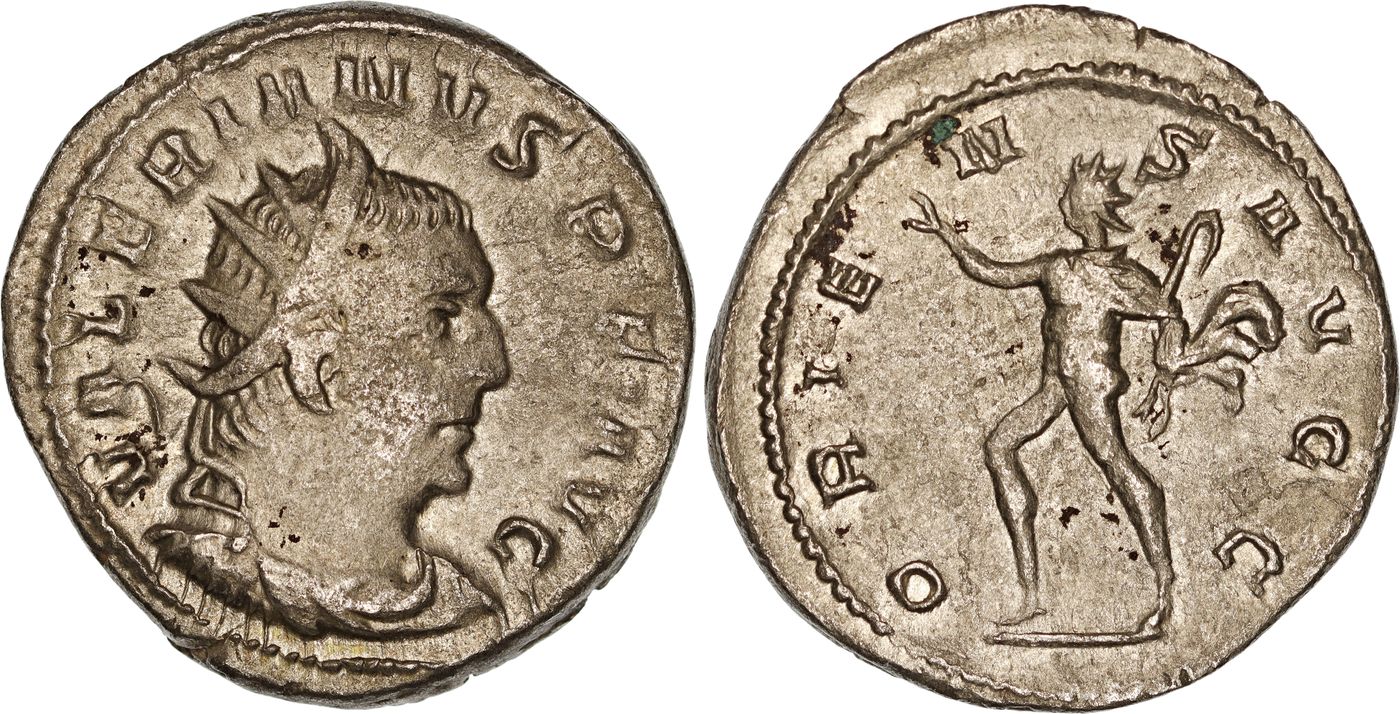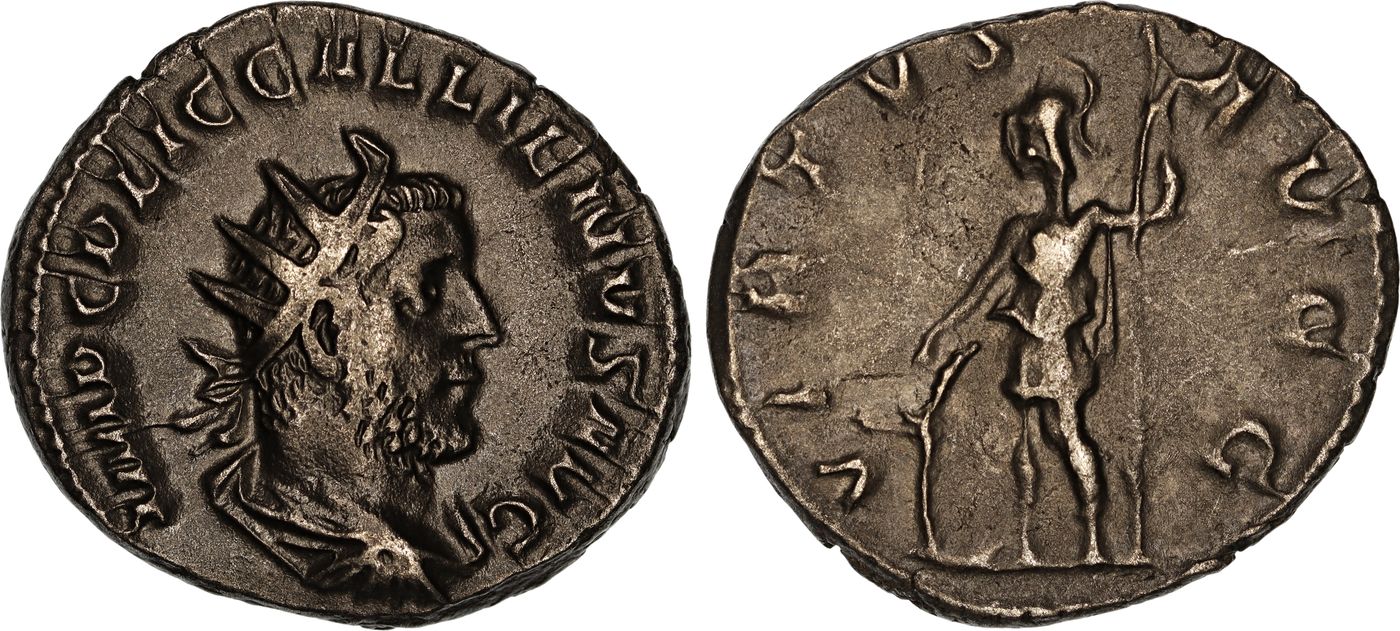The Tragedy of the House of Valerianus, gens Licia

Prelude: Trebonianus Gallus & Aemilian
The crisis of the Third Century, between the assassination of Severus Alexander in 235 AD and the accession of Diocletian to Augustus in 284 AD, was a period in which the Roman Empire nearly collapsed under the weight of barbarian invasions and migration, political instability through off-shoot empires and usurpers, and economic decline and continual debasement of currency. Throughout this period, the empire saw an unprecedented turnover of men claiming imperial power, many only ruling for several months before their assassination at the hands of their successor.
Commander of the Moesian legions, Marcus Aemilius Aemilianus was proclaimed emperor by legionaries under his command following his great victory against the Goths in 253 AD. Quick to further his claim as emperor, Aemilian moved to Italy where he would confront the current emperor Gaius Vibius Trebonianus Gallus, who, at the Battle of Interamna Nahars, was betrayed and killed by his own troops. Much like his predecessor Trebonianus Gallus, however, Aemilian would also be murdered by his soldiers after only 3 months as emperor when another Roman general, Publius Licinius Valerianus, was proclaimed Augustus and advanced on his position.

Aemilian, 253. Antoninianus (Silver, 22 mm, 3.23 g, 12 h), Rome. IMP AEMILIANVS PIVS FEL AVG Radiate, draped and cuirassed bust of Aemilian to right, seen from behind. Rev. MARTI PACIF Mars advancing to left, holding olive branch in his right hand and spear and shield in his left. Cohen 22. RIC 5b. Image courtesy of Leu Numismatik AG (Web Auction 25)
Rise of Publius Licinius Valerianus
Unlike the many others who vied for imperial power during the Third Century Crisis, Valerian was of a noble and traditional senatorial family and wished to emulate the Roman political structure of its former glory. He sought to establish a dynasty of gens Licinia, much in the image of the great dynasties which kept the empire politically stable before him – an example of which he would have witnessed firsthand as the family of Lucius Septimius Severus, the Severan Dynasty, held the throne during his early life. Therefore, upon ascending to power, Valerian elevated his firstborn son, Publius Licinius Egnatius Gallienus, to Augustus and co-ruler, and in order to combat the ever growing volatility of the empire, split the administration geographically whereby Gallienus would march west whilst his father to the east.
The Severen Dynasty: Lucius Septimius Severus and his firstborn son Marcus Aurelius Antoninus ‘Caracalla’ on two silver Denarii.
Unfortunately, this dynastic dream would not come to fruition as not only would both the sons of Gallienus be murdered, Publius Licinius Cornelius Valerianus, simply Valerian II, in 258 AD at Sirmium Illyria, and Publius Licinius Cornelius Saloninus Valerianus, simply Saloninus, in 260 AD at Colonial Agrippina at the hands of Marcus Cassianius Latinius Postumus, but Valerian I would meet an unprecedented fate during his Eastern campaign.

Publius Licinius Cornelius Valerianus, as Caesar and the first son of Gallienus, Silver Antoninianus, Cologne mint 257-258 AD. Obverse: Radiate-crowned and draped bust of Valerian II facing to the right, legend surrounds, “VALERIANVS CAES”. Reverse: Jupiter, portrayed as a child, sitting facing forward, head turned to left, atop goat standing right, raising right hand and holding goat’s horn with left, legend surrounds, “IOVI CRESCENTI”. RIC-3; Sear-10731. Lightly toned and quite complete in strike, the portrait noteworthy and engraved to portray the young Caesar much like his grandfather Valerian I.
The Fall of Valerian I
Moving his legions through Asia Minor, Valerian looked to recapture territory lost several years earlier to constant Persian invasions, first capturing Antioch in 257 AD and reclaiming the Roman province of Syria, and then addressing the Gothic invasion from the north the following year. Whilst engaging the Goths, who ravaged Pontus and moved further south into Cappadocia, an outbreak of the Plague of Cyprian weakened Roman numbers, slowing their advance, and the conflict would weaken the legions further. In 260 AD, Valerian moved his army east and was met by an unweakened, larger Sassanian army under Shahanshah, the King of Kings, Shapur I, in the fields between Carrhae and Edessa.
The following clash of two great empires, the Battle of Edessa of 260 AD, concluded with the Roman army’s thorough defeat and complete capture, including the surviving legionaries, many high-ranked officials, possibly including the Praetorian prefect, and the emperor Valerian I, becoming the first Roman Emperor to be taken as a prisoner of war, causing immense shock and instability throughout the entire Roman world.

Publius Licinius Valerianus, Roman Emperor 253-260 AD, Silver Antoninianus, Lyons mint 254 AD. Obverse: Radiate-crowned, draped and cuirassed bust of Valerian I facing to the right, legend surrounds, “VALERIANVS PF AVG”. Reverse: Sol advancing to the left, nude apart from radiate crown and chlamys, raising right hand and holding whip in left, legend surrounds, “ORIENS AVGG”. RIC-12; RSC-143a; Sear-9950. 
Sasanian Kingdom, Shapur I, AV Dinar. Mint I (“Ctesiphon”), Phase 2, circa AD 260-272. Draped bust to right, wearing diadem and mural crown surmounted by a korymbos; one pellet above and two below diadem ties / Fire-altar flanked by two regal attendants each wearing mural crown with ribbons and korymbos and holding staff; symbol to left of flames. SNS type IIc/1b, style P, group d/1; Göbl type I/1; Saeedi AV5; Sunrise 740. 7.44g, 21mm, 2h. Image courtesy of Roma Numismatics Ltd. (E-sale 103)
Gallienus, a tragic sole reign.
With the loss of his father and both Caesars, control of the whole empire fell to Gallienus alone who would rule for a further 8 years filled with back-to-back military engagements and socio-political unrest. Most notably, soon after Valerian’s defeat, the provinces of Britain, Spain and parts of Germania were lost to the aforementioned Postumus, the general and now Romano-Gallic Emperor responsible for the death of Saloninus, when he would declare the area an offshoot realm, now known as the Gallic Empire. Although confronted several times in battle, each would end in standstill and Postumus’ new empire would remain independent until 274 AD when it was conquered by Lucius Domitius Aurelianus.

Publius Licinius Egnatius Gallienus, as Roman Emperor and co-ruler with Valerian I 253-260 AD, Silver Antoninianus, Rome mint 254 AD. Obverse: Radiate-crowned and draped bust of Gallienus facing to the right, legend surrounds, “IMP C P LIC GALLIENVS AVG”. Reverse: Soldier stands facing to the left, helmeted and in military attire, holding spear in left hand and resting right on grounded shield, legend surrounds, “VIRTVS AVGG”. RIC-181.
It is unclear whether or not Gallienus thought the dynastic dreams of his father possible – it is likely, however, that following the murder of Saloninus so soon after the suspicious death of his first born son Valerian II, that these ambitions had diminished greatly. The emperor made no further attempt to further the imperial line of gens Licinia throughout the period of his sole reign, and never associated another family member, Egnatius Marinianus, who was possibly a third son, to any political rank other then Consul.

Gallic Empire, Marcus Cassianius Latinius Postumus, Romano-Gallic Emperor 260-269 AD, Æ Antoninianus (4.28g, 23mm), Cologne mint 261 AD. Obverse: Radiate-crowned, draped and cuirassed bust of Postumus facing to the right, legend surrounds, “IMP C POSTVMVS PF AVG”. Reverse: Roman galley with four rowers and single steer-man to the left, waves below, “AVG” in exergue, legend surrounds, “LAETITIA”. RIC-73; RSC-167; Sear-10958.
In 268 AD, the emperor’s authority was challenged by Aureolus, commander of the cavalry stationed in Mediolanum, who had claimed the title of emperor. During the siege, a conspiracy was led by several high-ranking Roman officials, primarily by Cecropius, commander of the Dalmatians, who spread the word that enemy forces were surrendering. Unsuspecting of any revolt, Gallienus left his tent without his bodyguard only to be struck down by his officers. Immediately thereafter, remaining Licinius family members, the emperor’s half-brother Licinius Valerianus Minor and Egnatius Marinianus, would be murdered as well – the closing chapter to the tragedy of the House of Valerian.
Although sometimes biased, the biographies of the Historia Augusta detail the ‘tyranni trīgintā’ of Gallienus, translated as the ‘Thirty Tyrants’ to act as pretenders to the throne of the Roman Empire during his reign; although the number may be off, I feel the historically tragic sentiment of his reign remains true.
Tragically, ancient historians would not treat the legacy of Gallienus favourably, highlighting his inabilities rather than what he had achieved given the circumstances. In addition to the several military victories across the West and East, he would contribute reforms to the Roman army that laid the foundation for the success of later men, notably Aurelian and Diocletian, two future emperors responsible for ending the Crisis of the Third Century.

I truly enjoy looking at on this web site, it contains excellent articles. Jonie Hugh Venterea